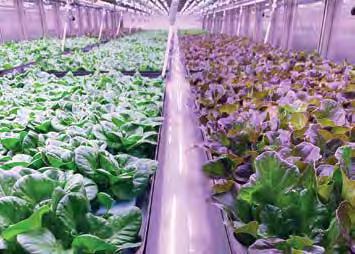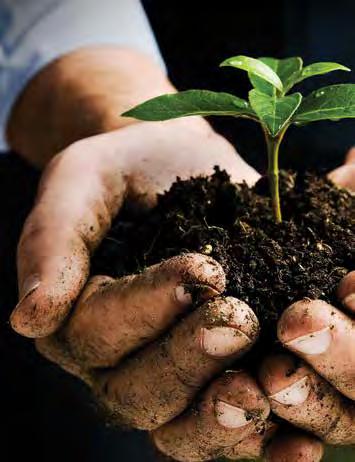
4 minute read
Are we on track for global sustainability, or disaster?
ARE WE ON TRACK FOR GLOBAL
SUSTAINABILITY, OR DISASTER?
Words by Heather Woods
Mike Zelkind, CEO and Co-founder of 80 Acres Farms in their newest automated farm, producing 10 million servings annually
According to the most recent estimates from the United Nations, the current world population is around 7.8 billion – that’s a lot of mouths to feed.
Throw in the human-dependent animal population and it’s clear that food production is a big deal. Birth rates may be trending downwards but we are living longer. Statistics NZ says the current average life expectancy is 82.5 years old, compared to just 71.5 years old in the 1970s. So general population numbers are trending upwards – in a hurry. So what are growers around the world doing to keep up with demand, but stay sustainable and protect the environment, that allows us to carry on each day? It all comes down one of the great challenges of our time: produce more food, but use less resources. And we need to be smart.
Dutch sustainability methods
Sir David Attenborough heralds the sustainability methods of growers in the Netherlands in his book A Life on our Planet. He says they are using less water, fewer pesticides, less fertiliser and have less carbon emissions, all while producing more food from less ground, and making the most of innovation – for instance by growing stacked crops. Innovation coming out of the Netherlands is plentiful, like floating farms, research into better ways of feeding livestock using waste food products, and investment into cuttingedge technology. Duijvestijn, a tomato grower, has been ahead of the curve for years using geo-thermal energy and hydroponics – and using 60% less energy. But while it sounds like the Dutch are forging the way – reducing waste and toxins, using less energy and with careful innovation, becoming the second-largest food exporter in the world – it is important to note that there are critics who look beyond the numbers into the geography of where the food production takes place, which is often in foreign territories, and question whether it should count towards their claim of ‘secondlargest’ exporter.
How the US are leading the pack
GreenTech, the global platform for horticulturalists, spoke to Mike Zelkind, the chief executive of 80 Acres Farms in the United States, who said: “Vertical Farms are expensive to build, but with much higher yields and drastically improved control to maximise nutrition, we can take farming to a whole new level.” When you dive deeper, it’s not just higher yields. Sure, they are producing 300 times more food than an average farm, but they’re also 100% pesticide-free, using 100% renewable energy and 97% less water. Further afield, the University of Idaho is experimenting with drone use for efficiencies in orchards, with new planting methods making space for the drones to fly, helping manage water, nutrients, pests, and estimating yield, with a side bonus of creating marketing collateral. And then there’s Blue River Technology, a California-based tech company that is taking robotics to new levels – their core mission is “solving monumental

Innovative vertical farm at 80 Acres Farms, Hamilton, Ohio, USA
challenges” in agriculture. Their ‘See & Spray’ technology means farmers can focus on individual plants in a sustainable way and create clean fields in which plants can thrive.
Is the Kiwi way up to scratch?
A recent news release from Horticulture New Zealand said, “If New Zealand is to meet its climate change and economic goals, growers and farmers need to be empowered to adapt and reduce emissions.” And importantly, a new postgraduate school has just launched in Canterbury, through the University of Canterbury, Lincoln University, Plant & Food Research, Manaaki Whenua Landcare Research, and AgResearch. Its purpose? Supporting a “transition to more future-focused, sustainable food systems and preparation.” So, while we’re doing a great job on education, there’s plenty of room for improvement with our current practices. Nicki Sutherland, group manager, investment & engagement at the Energy Efficiency & Conservation Authority (EECA) says, “there’s a high level of fossil fuel dependence by indoor growers in New Zealand. The good news is, there’s a huge opportunity for indoor growers to eliminate fossil fuels through prioritising energy efficiency and switching to low-emission fuel options, such as biomass and electricity. EECA has an active role in reducing fossil-fuelled process heat in New Zealand, across industry, commerce and the public sectors. We’ve demonstrated the benefits to be had from adopting clean and clever energy use, including lower energy costs and improved profitability. An energy audit has huge value: identifying and eliminating wasted energy use will have an immediate, measurable impact. From there, growers will likely be interested in technological solutions, and to that end, EECA is working directly with Horticulture New Zealand, Tomatoes NZ and Vegetables NZ to undertake an international technology scan into leading low carbon technologies.” And it’s simple to get the ball rolling. The EECA website explains how to make your systems efficient and adopt new technology. And you may be eligible for co-funding and support from EECA to do energy audits, plan an emissions reduction roadmap or adopt new and innovative technology. So even if growers feel they’re doing the best they can, research and a few phone calls could be the beginning of change. And just imagine if everyone made just a few small tweaks – the impact could be huge.
Are you a potential leader in the horticulture industry?
Want to know more?
www.hortnz.co.nz/leadership Sue Pickering 021 938 825, sue.p@developme.nz Deadline 20 June 2021











